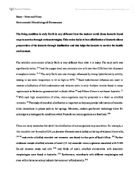Essay Writing On The Formation Of A.T.P
In the process of respiration there are 38 molecules of ATP, which are formed. This is done by a series of stages, which happen within all living cells. ATP is the short-term energy store of the cell. It is often called the ‘energy currency’ since it picks up energy from food in respiration and passes it on to power cell processes.
The four stages are known as, glycolysis, link reaction, kreb cycle and the electron transport chain. In the process of glycolysis, we are basically splitting up a glucose molecule into a three carbon chained pyruvates molecule, and this takes place within the cytoplasm, furthermore it is the only stage of anaerobic respiration. In the primary stage of thus first part of the whole process the glucose molecule is phosphorylated to make glucose phosphate by having one molecule of ATP transferred into ADP + Pi. The ATP basically lowers the activation energy in order to make the reaction more efficient. The glucose phosphate is further phosphorylated in order to produce fructose bisphosphate, using ATP, again for the same reason as above. At this stage, all the molecules produced are still 6 carbon molecules. Once the fructose bisphosphate has been produced, it then reacts and splits into two separate molecules of glycerate-3-phosphate, which is a 3 carbon, chained molecule. For the final stage of the process of glycolysis the molecule glycerate-3-phosphate is oxidised by a coenzyme, NAD. The glycerate-3-phosphate loses a hydrogen atom, which is transferred on the NAD molecules to turn the molecule into reduced NAD (NAD H+). This last stage also produces 2 ATP molecules on each glycerate-3-phosphate molecule by converting the earlier productions of ADP + Pi back into ATP. So in glycolysis we are left with 2 molecules of reduced NAD and ATP with a final product of pyruvates.







